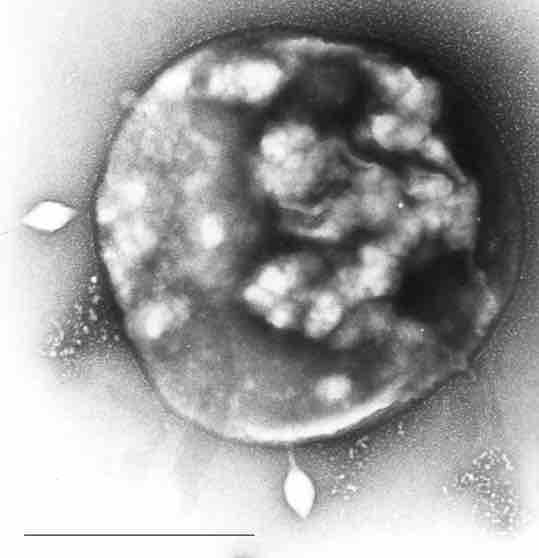Archaea usually have a single circular chromosome, the size of which may be as great as 5,751,492 base pairs in Methanosarcina acetivorans, the largest known archaean genome. One-tenth of this size is the tiny 490,885 base-pair genome of Nanoarchaeum equitans, the smallest archaean genome known. It is estimated to contain only 537 protein-encoding genes. Smaller independent pieces of DNA, called plasmids, are also found in archaea. Plasmids may be transferred between cells by physical contact, in a process that may be similar to bacterial conjugation.
Archaea can be infected by double-stranded DNA viruses that are unrelated to any other form of virus and have a variety of unusual shapes, including bottles, hooked rods, or teardrops. These viruses have been studied in most detail in thermophilics, particularly the orders Sulfolobales and Thermoproteales . Two groups of single-stranded DNA viruses that infect archaea have been recently isolated. One group is exemplified by the Halorubrum pleomorphic virus 1 ("Pleolipoviridae") infecting halophilic archaea and the other one by the Aeropyrum coil-shaped virus ("Spiraviridae") infecting a hyperthermophilic (optimal growth at 90-95°C) host. Notably, the latter virus has the largest currently reported ssDNA genome. Defenses against these viruses may involve RNA interference from repetitive DNA sequences that are related to the genes of the viruses.

Archaeal viral infection
Cell of Sulfolobus infected by virus STSV1 observed under microscopy. Two spindle-shaped viruses were being released from the host cell. The strain of Sulfolobus and STSV1 (Sulfolobus tengchongensis Spindle-shaped Virus 1) were isolated by Xiaoyu Xiang and his colleagues in an acidic hot spring in Yunnan Province, China. At present, STSV1 is the largest archaeal virus to have been isolated and studied. Its genome sequence has been sequenced.
Archaea are genetically distinct from bacteria and eukaryotes, with up to 15% of the proteins encoded by any one archaeal genome being unique to the domain, although most of these unique genes have no known function. Of the remainder of the unique proteins that have an identified function, most belong to the Euryarchaea and are involved in methanogenesis. The proteins that archaea, bacteria, and eukaryotes share form a common core of cell function, relating mostly to transcription, translation, and nucleotide metabolism. Other characteristic archaean features are the organization of genes of related function—such as enzymes that catalyze steps in the same metabolic pathway into novel operons, and large differences in tRNA genes and their aminoacyl tRNA synthetases.
Transcription and translation in archaea resemble these processes in eukaryotes more than in bacteria, with the archaean RNA polymerase and ribosomes being very close to their equivalents in eukaryotes. Although archaea only have one type of RNA polymerase, its structure and function in transcription seems to be close to that of the eukaryotic RNA polymerase II, with similar protein assemblies (the general transcription factors) directing the binding of the RNA polymerase to a gene's promoter. However, other archaean transcription factors are closer to those found in bacteria. Post-transcriptional modification is simpler than in eukaryotes, since most archaean genes lack introns, although there are many introns in their transfer RNA and ribosomal RNA genes, and introns may occur in a few protein-encoding genes.